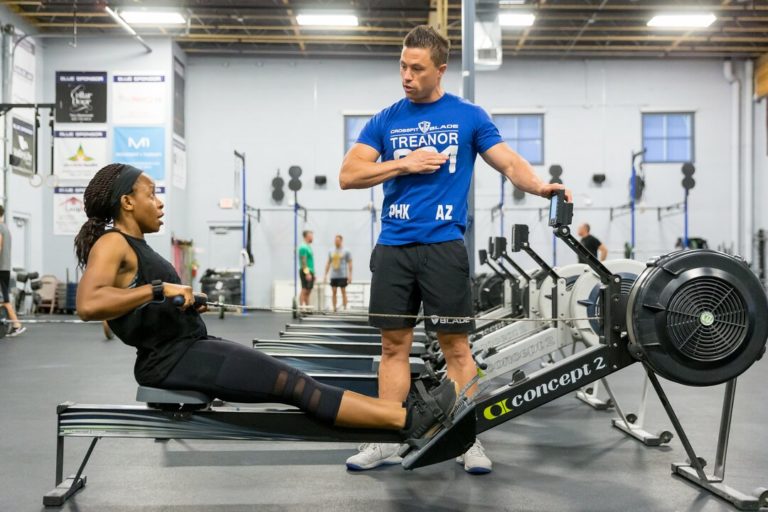There you are. You’re standing in front of your class, and you notice a few athletes who are new to you. You know they’ve been through a “foundations” program either at your gym or another, but you don’t know any more than that. And with coaching classes back-to-back, you didn’t have time to check in with them.
As a coach, your role is crucial in constantly observing and assessing your members. This is especially important for new athletes, as you need to determine the necessary adjustments for a given situation or desired training outcome. So, how can you work on developing this skill with these new members within the next hour without sacrificing the quality of the session for the rest of your athletes?
Pre-Workout
Here are a few things to consider, particularly during the warm-up, to ensure you meet each new athlete where they are and give them the best experience possible during class.
Assess Experience Level
Consider the length of time the member has been consistently training or practicing a specific movement or technique. Be sure to observe how they move and check their mechanics before pushing for more intensity via heavier loads, more repetitions, or faster execution. You can start by introducing yourself directly to them. Then ask questions like:
- What is their fitness background, and how many CrossFit classes have they attended?
- Do they remember having performed the movements before?
- Do they have any injuries you need to be aware of?
In addition, new athletes are likely to be nervous and uncertain. Let them know they can ask you a question anytime and reassure them you are there to help guide them throughout the session.

This can be a quick conversation that occurs while the rest of the athletes are hitting a warm-up run, while the athlete is on a piece of cardio equipment, or during a transition time when athletes gather equipment and get set up. Use this information as a starting point for thinking about their best scaling options.
Assess Technical Proficiency
Determine an individual’s skill level to complete a given movement or technique. Often, but not always, there is a direct relationship between an athlete’s experience level and their technical proficiency. During the build-up time, check in with the athlete multiple times to let them know exactly what they will do regarding the load, reps, rounds, etc.
This is another reason why allocating part of your class time for a group-guided specific warm-up under light load or no load and low intensity is critical, as is adequate build-up time. Not only does this practice prepare athletes for the workout, but it also allows coaches to assess athletes for scaling and mechanics.
During the Workout
Ideally, scaling parameters are in place before starting the workout, and no adjustments will need to be made during the workout. But it’s imperative coaches assess all athletes for safety, efficacy, and efficiency, and it’s inevitable that occasional adjustments will need to be made. Consider the following:
Fatigue
All athletes are expected to experience some degree of fatigue, but pay attention to signs of excess fatigue. Signs of excess fatigue could be a significant slowing in their pace that prolongs the workout and/or a decrease in technical proficiency. This consideration should be made from session to session. With new athletes, it is recommended to err on the side of “less is better” and focus on mechanics instead of intensity.
Remember that continuing to scale a member multiple times during a workout may unintentionally increase their intensity by not allowing for natural rest periods. Care should be taken not to over-scale a fatigued athlete. This is sometimes referred to as “progressive scaling.”
Check-in
It’s important to check in with the athlete periodically throughout the workout and ask how they are feeling and if they have any questions. This open line of communication is crucial, as it can reduce confusion and provide reassurance that they are on the right track.
Post-Workout
Allocating time (7-10 minutes) following the workout for cleaning up and cooling down facilitates recovery and allows for a chance to talk with your athletes. With new athletes, use this time to:
Highlight a Positive
CrossFit differs from an exercise regimen that most new athletes have done before and can be intimidating. Telling the athlete one or two specific things they did well during the class can create a positive mindset for the days to come and let them know they are on the right track. Consistency with this practice may be essential for them to stick with the program.
Ask More Questions
The post-workout time may allow you to ask more in-depth questions than the pre-workout timeframe. Ask them what got them interested in CrossFit, their job, their family, etc. Part of coaching and retention goes beyond the teaching, seeing, and correcting involved throughout the class and includes elements of relationship building. Taking the time to get to know your members may be critical to their success and perception of the program.
After Class
After completing the class, note what you did, what worked, what didn’t, and how you might change your approach next time. Perhaps most importantly, communicate information on the new athletes to the other coaches at your gym, including their level of experience, injury history, and factors to be aware of when coaching workouts (movement scaling options, volume considerations, etc.). This communication will not only help your coaches but will also improve the overall experience for the athlete.
Scaling for all levels and experience is a critical component and challenge for CrossFit coaches. Continually refining this practice will keep new-to-you members excited, engaged, and eager to return.
How to Coach and Scale New-To-You Members